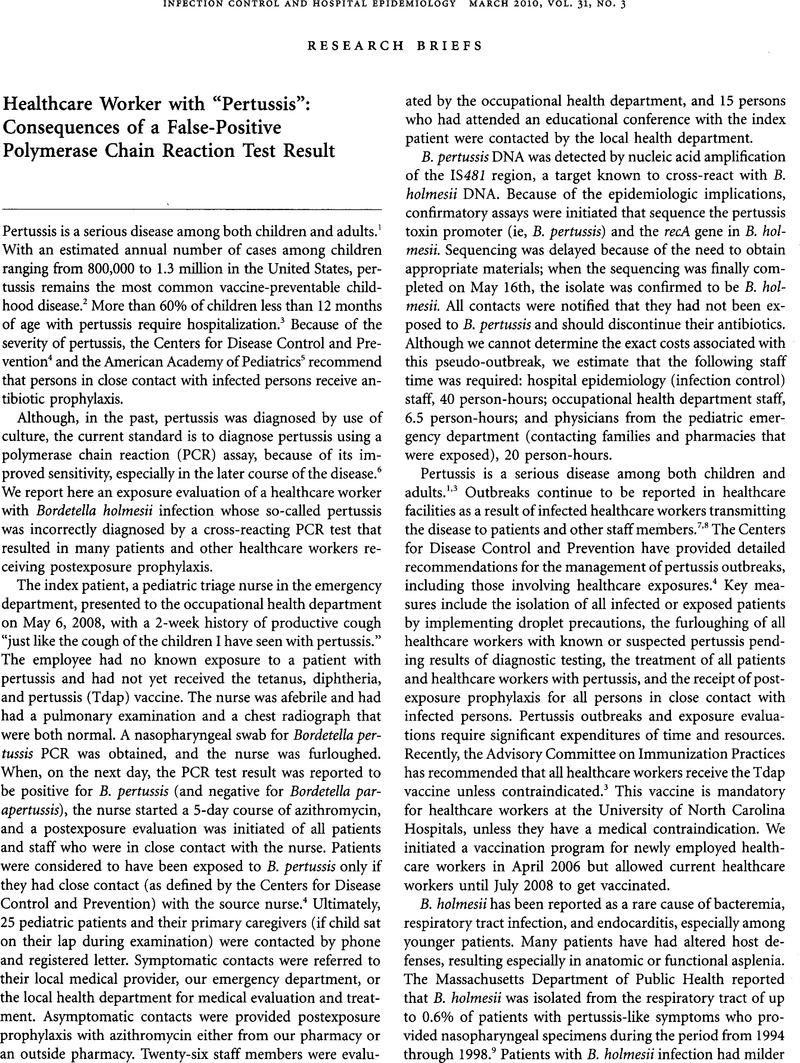Crossref Citations
This article has been cited by the following publications. This list is generated based on data provided by Crossref.
Loeffelholz, Michael
2012.
Towards Improved Accuracy of Bordetella pertussis Nucleic Acid Amplification Tests.
Journal of Clinical Microbiology,
Vol. 50,
Issue. 7,
p.
2186.
Snyder, John
and
Fisher, Donna
2012.
Pertussis in Childhood.
Pediatrics In Review,
Vol. 33,
Issue. 9,
p.
412.
Snyder, John
and
Fisher, Donna
2012.
Pertussis in Childhood.
Pediatrics In Review,
Vol. 33,
Issue. 9,
p.
412.
Rodgers, Loren
Martin, Stacey W.
Cohn, Amanda
Budd, Jeremy
Marcon, Mario
Terranella, Andrew
Mandal, Sema
Salamon, Douglas
Leber, Amy
Tondella, Maria-Lucia
Tatti, Kathleen
Spicer, Kevin
Emanuel, Allen
Koch, Elizabeth
McGlone, Londell
Pawloski, Lucia
LeMaile-Williams, Mysheika
Tucker, Naomi
Iyer, Radhika
Clark, Thomas A.
and
DiOrio, Mary
2013.
Epidemiologic and Laboratory Features of a Large Outbreak of Pertussis-Like Illnesses Associated With Cocirculating Bordetella holmesii and Bordetella pertussis—Ohio, 2010–2011.
Clinical Infectious Diseases,
Vol. 56,
Issue. 3,
p.
322.
Pittet, Laure F.
Emonet, Stéphane
François, Patrice
Bonetti, Eve-Julie
Schrenzel, Jacques
Hug, Melanie
Altwegg, Martin
Siegrist, Claire-Anne
Posfay-Barbe, Klara M.
and
Chan, Kwok H.
2014.
Diagnosis of Whooping Cough in Switzerland: Differentiating Bordetella pertussis from Bordetella holmesii by Polymerase Chain Reaction.
PLoS ONE,
Vol. 9,
Issue. 2,
p.
e88936.
Hassan, Ferdaus
Hays, Lindsay
Bell, Jeremiah
and
Selvarangan, Rangaraj
2014.
Evaluation of 3 analyte-specific reagents for detection of Bordetella pertussis and Bordetella parapertussis in clinical specimens.
Diagnostic Microbiology and Infectious Disease,
Vol. 80,
Issue. 3,
p.
181.
Pittet, Laure F
Emonet, Stéphane
Schrenzel, Jacques
Siegrist, Claire-Anne
and
Posfay-Barbe, Klara M
2014.
Bordetella holmesii: an under-recognised Bordetella species.
The Lancet Infectious Diseases,
Vol. 14,
Issue. 6,
p.
510.
van der Zee, Anneke
Schellekens, Joop F. P.
and
Mooi, Frits R.
2015.
Laboratory Diagnosis of Pertussis.
Clinical Microbiology Reviews,
Vol. 28,
Issue. 4,
p.
1005.
Calderón, Tirza A.
Coffin, Susan E.
and
Sammons, Julia S.
2015.
Preventing the Spread of Pertussis in Pediatric Healthcare Settings.
Journal of the Pediatric Infectious Diseases Society,
Vol. 4,
Issue. 3,
p.
252.
Pittet, Laure F.
and
Posfay-Barbe, Klara M.
2016.
Emerging Infections 10.
p.
239.
Pittet, Laure F.
Posfay-Barbe, Klara M.
Scheld, W. Michael
Hughes, James M.
and
Whitley, Richard J.
2016.
Bordetella holmesii
: Still Emerging and Elusive 20 Years On
.
Microbiology Spectrum,
Vol. 4,
Issue. 2,
Plongla, R.
and
Miller, M.B.
2017.
Diagnostic Molecular Pathology.
p.
139.
Thompson, Cecilia M.
2024.
Diagnostic Molecular Pathology.
p.
133.



